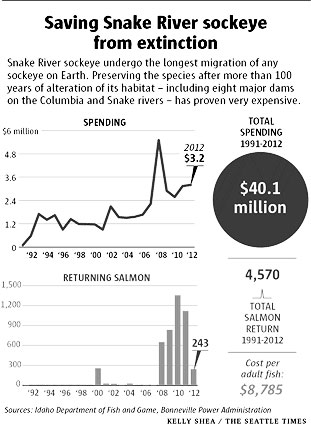From the Seattle Times Saturday before last comes this readable review of recent efforts to preserve and rebuild the Snake River Sockeye – The Extraordinary Effort to Save Sockeye Salmon penned by Lynda V. Mapes.
REDFISH LAKE CREEK, Idaho —
A vermilion slash in clear, cold water, the Snake River sockeye in this mountain stream is one of nature’s long-distance athletes, traveling at least 900 miles to get here.
That this fish can make such a journey — the longest of any sockeye in the world — is remarkable. But it’s more incredible that this fish is still around at all.
Down to just one known fish — dubbed Lonesome Larry — in 1992, state, tribal and federal fish managers have painstakingly preserved the species in captivity ever since.
Twenty years and $40 million later, they have a new goal. Not just mere survival for Snake River sockeye, but rebuilding the run to at least 2,500 wild fish, free of any hatchery influence, making the epic journey all the way from the Pacific across a time zone to the high mountain lakes of Idaho.
The story is a fascinating one, considering the run was in 1992 down to just one fish, Lonesome Larry, and particularly given the fact that this sole survivor was stripped of his milt, summarily executed (presumably for posterity) and mounted in the Redfish Lake Nature Center.
Larry’s genetic essence has apparently been stingily dribbled out over the years as part of the effort to rebuild the run and breed what are more or less captive brood stock.
 To the team’s credit there have been returns over the past several years, though in proud ‘only in American’ fashion, the input cost for each returning fish has been damned close to $9000. One doesn’t have to use a great deal of imagination to visualize this program on some crusading politico’s austerity program chopping block.
To the team’s credit there have been returns over the past several years, though in proud ‘only in American’ fashion, the input cost for each returning fish has been damned close to $9000. One doesn’t have to use a great deal of imagination to visualize this program on some crusading politico’s austerity program chopping block.
Spending a bit of time here in Washington state it’s been nothing but fascinating to begin to get a glimpse into the policies, politics and byzantine inertia of fisheries management. My where I sit (along with seemingly a majority of those I’ve talked to of late) management approaches seemingly cling more to bureaucratic kingdom protection and can-kicking than proactive, more aggressive approaches to restoration of stressed and dwindling native populations.
Naysayers duly noted, my hat’s off to these noble fish that will swim 900 miles, gaining roughly 6500 feet in elevation, surmounting eight dams among a host of other natural hazards to spawn in Redfish Lake Creek.
Would you swim 900 miles to have sex and die? That depends……
Images: Top – NOAA Fisheries; bottom – Seattle Times.


